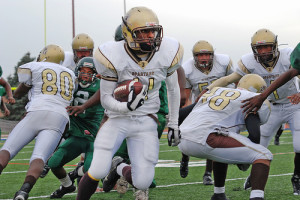
Win or lose, high school football coaches dedicate countless hours to reviewing game video after every game. From assessing how not to repeat missed passes and fumbles to figuring out how to replicate big plays, Monday’s breakdown of the weekend’s performance has been a long-standing football tradition that remained intact until 2013, when changes to the National Federation of State High School Associations’ Rule 1.6.1.2 were made.
Starting in 2013, players and coaches no longer had to wait until the following week to watch the footage from the previous weekend’s game. In fact, it’s now legal to review plays during the course of a game and, as a result of these rule changes and technological advancements, the game itself has changed significantly during the past two years.
Real-Time Review Means Real-Time Improvements
By being able to evaluate their own strengths and weaknesses in real-time from the sidelines, players and coaches can make improvements and adjustments while the game is still happening. Conversely, they can see where the opposing team is having problems and identify strategies to thwart their defenses and stop their offensive attack. With technology that allows coaches to watch plays on their tablets or smartphones right after they’ve occurred, they can re-evaluate strategies that may have worked well in practice, but just aren’t effective come game time.
Player Involvement
Watching instant replays isn’t the only way high school football is benefitting from technological advancements. While the weekly viewing of last weekend’s game used to be the only time most of the team got to see this footage, coaches are now able to share this video with individual players. Players can study footage of specific plays or entire games from their smartphones, tablets, and computers on their own time, identifying their own strengths and weaknesses before school and after practice. Coaches from different teams, on the other hand, can exchange footage with each other by simply uploading their games online rather than exchanging physical tapes or discs, as has been done in the past. The ability to tag specific plays also eliminates the need to fast forward or rewind to the exact play being referenced.
Long-Term Evaluation
Having this footage more easily accessible also allows players and coaches to identify broader ways of improving their skills, not just from game to game, but from season to season. For example, if a coach notices a wide receiver has the agility to catch most passes and is fast enough to get the ball down the field, but is brought down by even the slightest hit, he can have that player improve on his strength and power. Or if a defensive lineman is able to explode through anyone in front of him, but can’t catch up to the quarterback before the pass is made, the coach can have that player work on speed and stamina training.
College Recruitment
Having all this footage available in a centralized online location also makes it easier for college scouts to view footage of high school players and determine which ones might be right for their teams. So, if a high school coach can quickly reference a particular player’s more impactful plays, college scouts can more quickly identify the players they’d like to recruit to their schools.
Though studying film is nothing new in high school football, the way it’s studied and its immediate availability is changing the strategies of coaches and teams. While nothing is likely to replace those post-game evaluations or on-field practices, technological advancements in video are definitely making it easier to identify what a player or team is doing right and where they have room to improve. Whether that’s happening in real time from the sideline or by reviewing footage that previously wouldn’t have been so easily accessible to players and other coaches, the rule changes over the past few years are allowing high school teams to capitalize on these new developments in video as rapidly as they happen.
What do you think? Does having access to game footage as the game is in progress increase your team’s chances of winning?
Photo Credit: Kevin Casey Fleming via Compfight cc

